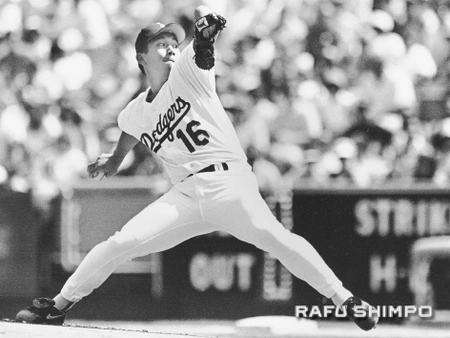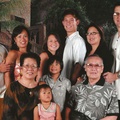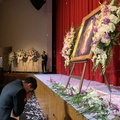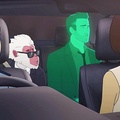I drew this cartoon in May 1995, Hideo Nomo’s first season as a Dodger. All those years ago, it struck me that besides being a great pitcher, Nomo would inspire young Japanese Americans to dream that maybe, one day, they could play in the Major Leagues.
Nomo, with his signature “tornado” wind-up, blazed the trail for so many who have come after him: Ichiro Suzuki, Kenta Maeda, Hideki Matsui, Hiroki Kuroda, Yu Darvish, the list goes on and on. Not only players from Japan; think of the Nikkei athletes who have made their mark since Nomo: Kurt Suzuki, Lars Nootbar, Kyle Higashioka, Keston Hiura, Lenn Sakata, Jordan Yamamoto.
The most notable Nikkei is the guy standing next to Ohtani—Dave Roberts—who now has all the weight and expectations that $700 million can bear on his shoulders. It’s World Series or bust.
I was living in Tokyo when Nomo pitched his no-hitter against the Colorado Rockies on Sept. 17, 1996. To do it in such a hitter-friendly park was incredible. Back then, NHK would only show the half of the inning when Nomo pitched, so watching the replay was fast and a bit truncated but still thrilling.
There will be no turning away from games now that it’s Sho-Time. Two decades later, the biggest star on the planet is now wearing Dodger Blue.
Ohtani demurred on a question from Josie Huang of LAist of his impact on the local Japanese American community. That felt right. After all, he has spent the last five seasons in Orange County, which has a large JA population. He inspired Japanese American and Japanese fans, all wearing red, and cheering for their hero.
Going to Angels games sometimes felt like being in Little Tokyo. You’d run into so many familiar faces there, walking through the pavilion.

Now all that energy and excitement will be in Chavez Ravine. As much as I cheer as a Dodger fan, you can’t help but feel bad for the hapless Angels. Their fanbase deserves better and baseball fans should appreciate that the Angels were willing to let Ohtani be Ohtani, rather than force him to choose pitching or hitting.
It was Dodger announcer Stephen Nelson, who is Japanese American, who captured what the moment meant: that impact of a player of Ohtani’s caliber marks a cultural moment, larger than sports itself. In an interview after the press conference with Kirsten Watson, Nelson noted that L.A. is home to one of the largest concentrations of Japanese outside of Japan. As anyone who reads The Rafu knows, it’s not just L.A., it’s places like Torrance, Gardena, Irvine, Monterey Park, Sawtelle, RPV — all these parts of SoCal have many JAs who call it home.
From Dodger Stadium you can almost see Little Tokyo, the last of three Japantowns in California. Maybe one day Ohtani will take a trip to the Japanese American National Museum, and learn some of the history that happened to Japanese Americans in Los Angeles. Or maybe he’ll grab a bite at Kouraku or any of the other great restaurants or buy a Japangeles sweatshirt. (He can afford it.)
I remember strolling by Mitsuru Grill on First Street and seeing Kuroda walk by. Although Ohtani lives in Newport, maybe he’ll get a little taste of J-Town now that he’ll be here in L.A.
So many of those players who have transcended their sport have been here in Los Angeles. He joins the likes of Jackie Robinson, Fernando Valenzuela, Billie Jean King, Kareem Abdul Jabbar, Magic Johnson, Tiger Woods, Kobe Bryant, and Venus, and Serena Williams. Ohtani joining the Dodgers is another page for the history books. Although it has many problems, California is still the Golden State where if you’re talented, dreams can happen.
The new season can’t start soon enough. In the middle of December, it’s time to dream of spring.
*This article was originally published in the Rafu Shimpo on December 16, 2023.
© 2023 Gwen Muranaka






